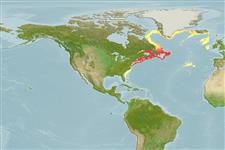Classification / Names
Common names from other countries
Main reference
Size / Weight / Age
Max length : 133 cm TL male/unsexed; (Ref. 40637); 135.0 cm TL (female); common length : 70.0 cm TL male/unsexed; (Ref. 1371); max. published weight: 21.0 kg (Ref. 4699); max. reported age: 23 years (Ref. 796)
Length at first maturity
Lm 46.0, range 48 - ? cm
Environment
Marine; demersal; oceanodromous (Ref. 51243); depth range 100 - 1000 m (Ref. 5951), usually 100 - 247 m (Ref. 1371)
Climate / Range
Temperate, preferred 5°C (Ref. 107945); 66°N - 27°N, 81°W - 13°W
Distribution
Western Atlantic: Labrador and the Grand Banks of Newfoundland to the coast of North Carolina. Straying to Iceland in the east and Florida in the south.
Countries | FAO areas | Ecosystems | Occurrences | Introductions
Short description
Dorsal
spines
(total): 0;
Anal
spines: 0. Upper limb or first gill arch with 2 (rarely 3) rakers. First dorsal in with an elongated ray. Body color variable, dorsally various dark shades, paler laterally, sometimes bronze, belly pale dirty to yellow white; pelvic fin pale. A dusky blotch present on the opercle.
IUCN Red List Status (Ref. 115185)
Threat to humans
Harmless
Human uses
Fisheries: highly commercial; gamefish: yes
Tools
Special reports
Download XML
Internet sources
Estimates of some properties based on models
Phylogenetic diversity index
PD50 = 0.5044 many relatives (e.g. carps) 0.5 - 2.0 few relatives (e.g. lungfishes)
Trophic Level
4.3 ±0.5 se; Based on diet studies.
Resilience
Low, minimum population doubling time 4.5 - 14 years (K=0.11; tm=2; tmax=23; Fec=1 million)
Vulnerability
High to very high vulnerability (72 of 100)
Price category
